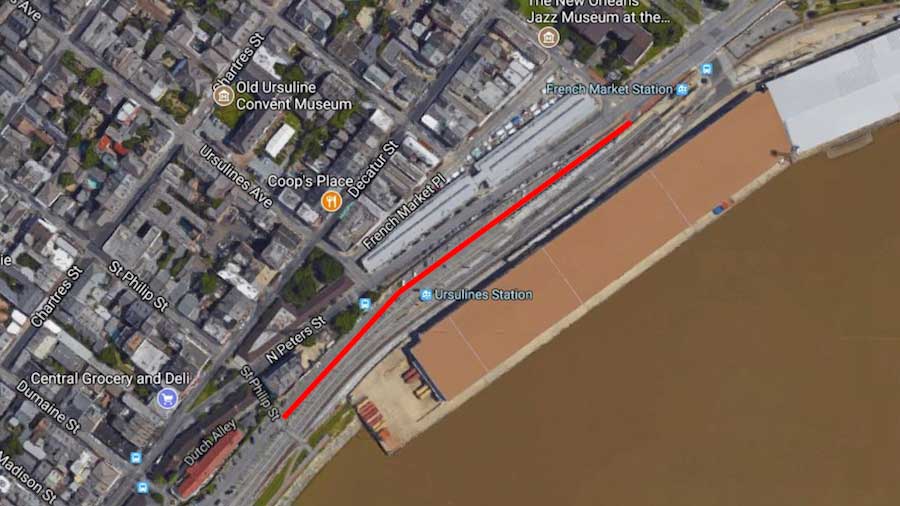The U.S. Army Corps of Engineers is embarking on a $4.53 million project to replace a 400-ft-long section of Mississippi River flood wall behind the French Market.
MTC Construction LLC of St. Martinville, La., won the contract from the Corps in September to complete the 18-month project, which is scheduled to begin this month.
The project entails upgrading the existing T-wall with a stronger, taller T-wall to reduce risks from Mississippi River flooding. The flood wall had been identified as an area in need of improvement, and funding for the project became available after the start of the fiscal year on Oct. 1.
“It was the most at-risk point on the Mississippi River and Tributaries project because of the bend in the river right there,” says Matt Roe, public affairs specialist for the Corps’ New Orleans district. “Undertaking the project will bring that section of the wall into compliance with newer Corps standards.”
MTC Construction will replace and raise nine flood wall monoliths to complete the new section. The top of the new wall will be 22.6 ft above sea level, which is 1.7 ft higher than the existing wall. Adjacent sections of the wall will not be the same height as the new construction.
Whereas the old wall was built on a foundation of concrete and timber piles, the new wall will have the support of 18-in diameter steel-pipe piles to better fortify it. Similar to the old structure, steel sheet piles will provide the support for the cutoff wall.
The job site will be in the French Market’s public parking lot between the river and the market, from the flood wall gate at St. Phillip Street to the gate at Barracks Street.
Because the project entails an extensive amount of steel pile driving in a crowded tourist area, project officials have had to carefully consider how to proceed with construction.
“One of the challenges for this project is going to be its location. It’s adjacent to the French Market and a very busy business area,” Roe says.
To minimize construction impacts to the French Market, the sheet piles will be driven using a non-impact, non-vibrating press-in method instead of a vibrating hammer. The method involves pushing piles into the ground instead of hammering them and greatly reduces vibrations in the surrounding area.
“This method has been used on SELA drainage projects around the Uptown area very successfully,” Roe says, referencing the Southeast Louisiana Urban Flood Control Project to reduce the risk of rainfall flooding in Orleans, Jefferson and St. Tammany parishes.
Public safety is another challenge, according to MTC Construction owner Monique Clark. Crews will be working in the tight confines of the French Quarter, and the public parking lot along the riverfront will remain open throughout the project.
Overhead power lines will be another concern, as construction will occur almost directly under Entergy Corp. transmission lines. This will require the splicing of foundation pipe piles, Clark says.
There will also be limits on how much construction and demolition can take place at one time. “To minimize vulnerability during both high river and hurricane season, the contract is limited to the construction of two monoliths at a time,” Clark says.
The Regional Transit Authority’s riverfront streetcar stop at Ursulines Street is the only stop that will remain closed during construction. Street traffic should not be affected.
The flood wall improvements are part of the Mississippi and River Tributaries Project to reduce risks from Mississippi River Flooding. The project dates back to 1928 and has included $14 billion in spending in the Greater New Orleans area on levee construction and improvements, the Bonnet Carre Spillway and the Morganza Floodway.
The Corps is coordinating the construction process with the city of New Orleans.



Post a comment to this article
Report Abusive Comment